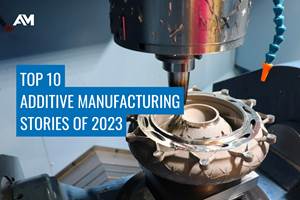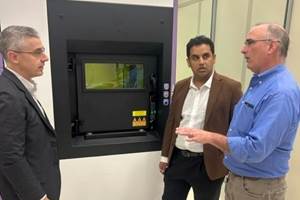Researchers Use Additive Manufacturing to Make Aircraft Propulsion Systems More Eco-Friendly
Project researchers aim to utilize hydrogen fuel cells and additive manufacturing as a pathway to achieve low-emission aviation by 2050. The goal is to recuperate the waste heat of a fuel cell-electric propulsion system, paving the way for a clearer, more sustainable future in aviation.
Share
Read Next
Example of a topologically optimized multimaterial heat exchanger, manufactured using LPBF technology. Source: exFan
A project spearheaded by exFan is focusing on using additive manufacturing (AM) to transform aircraft propulsion systems to achieve low-emission aviation by 2050. The primary objective is to pioneer the development of a state-of-the-art recuperation device, leveraging the Meredith effect to optimize the conversion of exergy from anergy.
Initiated in December 2023, the project “Novel Recuperation System to Maximize Exergy from Anergy for Fuel Cell Powered Geared Electric Aircraft Propulsion System,” or exFan for short, is a research initiative funded by the European Union under GA 101138184, as part of the Horizon Europe program. Scheduled for a period of four years, this project involves a consortium of 10 partners from five different countries. Organizers say the project is a path to low-emission aviation by 2050 made possible with hydrogen fuel cells and additive manufacturing.
CIDETEC Surface Engineering leads the project coordination, in collaboration with ADT as the technical coordinator and TU Wien (TUW) as the research coordinator. The exFan project is a collaborative endeavor involving academia, industry and aeronautical associations, focused on integrating a ducted heat exchanger into the nacelle of a megawatt-class electric aircraft. Key partners, including Fraunhofer IAPT, DLR, PowerID, EASN-TIS, IRES, FZG/TUM and Egile Mechanics, contribute their specialized expertise and resources to advance the project.
The project is focused on revolutionizing aircraft propulsion systems by developing a cutting-edge recuperation device, harnessing the Meredith effect to maximize exergy from anergy. The Meredith effect occurs when air flowing through a duct is heated by a heat exchanger or radiator containing a hot working fluid. The exFan project introduces a novel thrust-generating heat dissipation and recuperation system within a megawatt-class-geared electric fan propulsion setup. The goal is to recuperate the waste heat of a fuel cell-electric propulsion system, paving the way for a clearer, more sustainable future in aviation.
Zero Emissions in Flight
Hydrogen-powered aircraft propulsion is a key player in crafting an eco-friendly aviation landscape. By using fuel cells, exFan ensures zero in-flight CO2 emissions, addressing the pressing environmental concerns of modern air travel.
Tackling Thermal Challenges
As we propel toward 2030, fuel cell electrical efficiencies are anticipated to reach 50%. However, with every watt of electricity produced comes a watt of heat that needs efficient dissipation. The exFan project is an example of tackling the thermal management challenge in fuel cell-powered aviation. The research team is dedicated to investigating solutions that not only dissipate waste heat without introducing drag losses but also ingeniously convert this excess heat into additional thrust for the aircraft. Imagine a propulsion system that maximizes efficiency without compromise.
Hydrogen Fuel Cell Technology
The initiative aims for innovative advancements by integrating a geared electric fan propulsion system driven by hydrogen fuel cell technology. However, fuel cell technology produces an equal amount of waste heat for each watt of electricity generated. Effectively harnessing this byproduct is crucial for achieving the desired efficiency. The Meredith Effect describes how air flowing through a duct undergoes compression before the heat added by surrounding components leads to an expansion, resulting in an accelerated airflow that creates additional forward thrust. This process utilizes a heat exchanger to transfer the waste heat to the duct, thereby enhancing propulsion efficiency.
Making use of the Meredith Effect in commercial aircraft would be a groundbreaking advancement toward a more sustainable future in global transportation, though it also presents considerable technological challenges. The design of the heat exchanger in the exFan project is planned to feature a complex yet lightweight, bio-inspired structure (see photo). It will have a surface finish designed to prevent particle accumulation, corrosion and erosion — factors vital for maintaining the exchanger’s integrity and efficiency under rigorous flying conditions. In addition to the main heat exchanger, the project is developing an innovative thermal management system aimed at enhancing the quality of the waste heat and precisely managing the heat flux throughout the propulsion system, ensuring optimal operating conditions.
The hydrogen fuel cells currently under development produce no CO2 emissions during flight, making them more sustainable compared to traditional kerosene-fueled engines. Hydrogen is both abundant and renewable, positioning it as a cornerstone for achieving aviation’s climate goals. However, the adoption of hydrogen-powered propulsion faces technical hurdles, particularly in thermal management and heat dissipation within aircraft systems. Unlike turbine engines that expel excess heat through the exhaust, fuel cells and batteries accumulate heat, necessitating advanced thermal management systems to maintain optimal operating temperatures. Current projections suggest that by 2030, the electrical efficiency of fuel cells could reach 50%, indicating significant heat generation that, if harnessed effectively, could further enhance aircraft performance.
Functional Lab-Scale Tests
To validate the theoretical models, the partners of the exFan project will develop a simulation model to fine-tune operational parameters. This model will undergo initial functional lab-scale tests to compare against real-world conditions, providing essential data to further refine the system. These tests are crucial for transitioning from theoretical frameworks to practical, deployable solutions that can be incorporated into future aircraft designs.
Addressing key challenges such as thermal management and heat rejection in hydrogen-powered aircraft propulsion, the exFan project holds potential to impact the aerospace sector’s shift toward low-emission aviation by 2050. This impact is facilitated through its integration of advanced AM techniques and a focus on efficient, sustainable heat recovery strategies. Compared to conventionally manufactured counterparts, the advantages of AM heat exchangers include significant weight reduction, enhanced thermal efficiency, and increased component durability.
By employing high-temperature aluminum alloys and advanced generative designs, the use of AM in the exFan project facilitates the development of more efficient components that meet the rigorous demands of aerospace engineering. Furthermore, the project will not only enhance the heat exchanger's performance but also reduces maintenance requirements and operational costs, contributing to overall fuel and cost savings. This aligns with the broader objectives of the European Green Deal and the global push toward more sustainable air travel.
Path to Sustainability
As the aviation sector accounts for a significant portion of global CO2 emissions, it is imperative to adopt new technologies that can lead to cleaner and more efficient aircraft. Hydrogen fuel cells offer a zero-emission alternative to conventional jet fuel, but integrating this technology into commercial aviation requires overcoming substantial engineering challenges. Therefore, the European Green Deal has set a goal for environmentally friendly aviation by 2050, highlighting hydrogen-powered aircraft as a key solution to reduce CO2 emissions.
According to Fraunhofer IAPT, the aviation sector’s shift toward sustainability highlights the significance of additively manufactured heat exchangers in aircraft design. These components, crucial for hydrogen fuel cell-powered systems, could revolutionize aircraft propulsion through their intricate, thermally optimized structures. This innovation not only supports CO2 reduction goals but also boosts aircraft efficiency and performance. While adopting AM heat exchangers broadly could reduce production costs and promote widespread use, challenges such as ensuring part reliability and durability under harsh flight conditions and scaling up production while maintaining quality need to be addressed.
The high temperatures and pressures, along with the need for consistent performance over many flight cycles, require rigorous testing and validation of AM components. Additionally, scaling up AM processes for high-volume production while maintaining precise quality control is not trivial and requires advancements in both the technology and manufacturing processes. Despite these challenges, the future of additively manufactured heat exchangers in the aviation sector looks promising. With continued research, development, and collaboration across the aerospace industry, these innovative components are poised to play a crucial role in achieving environmentally friendly aviation by 2050.
Fraunhofer IAPT says that AM emerges as a critical enabler in this transition, enabling the precise and cost-effective production of complex parts needed for hydrogen fuel systems and thermal management components. This facilitates the development of lighter, more efficient aircraft components. These innovations are essential for meeting the stringent performance and safety standards of the aerospace industry while aligning with environmental goals.
For more information, please visit the exFan website.
Related Content
Video: How Multimaterial Laser Powder Bed Fusion Works
Penn State University’s CIMP-3D is exploring applications of the Schaeffler Aerosint system for multimaterial 3D printing. During a recent visit, I got an introduction to this system.
Read MoreTop 10 Additive Manufacturing Stories of 2023
Laser powder bed fusion, proprietary AM processes, machining and more made our list of top 10 articles and videos by pageviews this year.
Read MoreNew Zeda Additive Manufacturing Factory in Ohio Will Serve Medical, Military and Aerospace Production
Site providing laser powder bed fusion as well as machining and other postprocessing will open in late 2023, and will employ over 100. Chief technology officer Greg Morris sees economic and personnel advantages of serving different markets from a single AM facility.
Read MorePreassembled Turbojet Engine, 3D Printed in One Build: The Cool Parts Show #75
Turbojet engines typically consist of hundreds or thousands of parts, but this engine — 2023 winner of The Cool Parts Showcase for Best Proof of Concept — was 3D printed as just two pieces, with the monolithic rotor embedded inside the stationary engine shell.
Read MoreRead Next
Postprocessing Steps and Costs for Metal 3D Printing
When your metal part is done 3D printing, you just pull it out of the machine and start using it, right? Not exactly.
Read MoreBike Manufacturer Uses Additive Manufacturing to Create Lighter, More Complex, Customized Parts
Titanium bike frame manufacturer Hanglun Technology mixes precision casting with 3D printing to create bikes that offer increased speed and reduced turbulence during long-distance rides, offering a smoother, faster and more efficient cycling experience.
Read MoreProfilometry-Based Indentation Plastometry (PIP) as an Alternative to Standard Tensile Testing
UK-based Plastometrex offers a benchtop testing device utilizing PIP to quickly and easily analyze the yield strength, tensile strength and uniform elongation of samples and even printed parts. The solution is particularly useful for additive manufacturing.
Read More





















